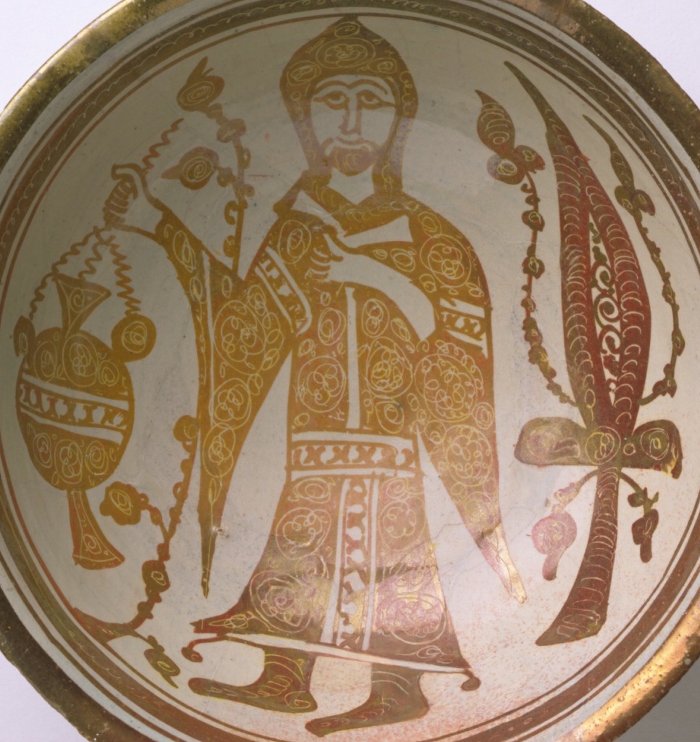Fatimid Coptic Priest on plate, 11th Century
 A larger image of this Fatimid Coptic Priest on plate, Victoria and Albert Museum. |
 A larger image of this Fatimid Coptic Priest on plate, Victoria and Albert Museum. |
This Egyptian bowl has lustre decoration. It is one of the finest complete examples of the lustre-decorated pottery produced in Egypt under the Fatimid dynasty (ruled 969 -1171). Decorators had transferred the technique of painting in lustre over the glaze from glassware to pottery in Iraq at an earlier date. However, the quality of Egyptian wares of the Fatimid period is often much higher, as in this case. The decoration on the interior of the bowl shows a hooded man carrying a lamp or censer suspended on chains. The space to his left is filled with a cypress tree. The man has traditionally been identified as a Coptic priest. (The Copts are Egyptian Christians who have lived under Muslim rule since the 7th century AD and still form a substantial minority of Egypt's population.) The Arabic word Sa'd appears twice, back to front, on the outside of the bowl. It means 'happiness' but is also a common man's name. The same inscription appears on many other Egyptian lustre wares. It is not clear what it signifies. It may be a potter's signature, a workshop mark or the expression of a good wish by the maker for the future owner. Experts have dated this bowl to between 1050 and 1100. This is because a similar item was built into the facade of the church of San Sisto in Pisa, Italy, which was begun in 1070.
Source: Victoria & Albert Museum, London
273. Bowl with Coptic Monk
-----------------------------------
Fatimid (Luxor), second half of 11th century
Glazed, luster-painted, and incised composite body
H. 9.6cm (3¾ in.), DIAM. 22.3 cm (8¾ in.)
CONDITION: The bowl is repaired.
PROVENANCE: Found near Luxor(?); Dikram Garabed Kelekian collection.
The Board of Trustees of the Victoria and Albert Museum, London, England (C49-1952)
Reputedly found in Luxor, Egypt, this bowl is the only extant complete luster-painted bowl produced under the patronage of the Fatimid dynasty (969-1171) that bears a Christian subject as its sole interior decoration.1 A figure with a goatee and wearing a cowl or hood carries in his right hand a large lamp suspended from three chains. To his left can be seen a representation of an ankh, the ancient Egyptian hieroglyphic sign for life, which the Christian Egyptians, or Copts, adapted to their new faith.2
Although we know that the market both for the bowl and for two related fragments was Christian, we cannot even speculate about the religion of the artisan or artisans who created them. Cairene society was at this time so pluralistic that all guilds most likely included Muslims, Christians, and Jews.3
The principal decoration on the exterior of this bowl consists of the Arabic word sa'd, repeated twice. This benediction, meaning "good luck", "good fortune," or "good omen,' appears as part of the decoration on a group of forty-six objects created during the Fatimid period that has been dated to the last half of the eleventh century on the basis of comparisons with the decoration on dated or datable textiles from the period.4 Further substantiating this dating is the fact that a bowl of very similar shape, technique, and style was found set into the facade of the Church of San Sisto in Pisa, which was built and decorated between 1070 and 1088.5
M J-M
1. Two fragmentary luster-painted objects of the same period with Christian subject matter are known: one, in the Museum of Islamic Art, Cairo (see Cairo 1930, p1. XXXII.2); and a second fragment, in the Staatliche Museen zu Berlin, Museum für Islamische Kunst.
2. Contrary to the opinion of Contadini (in Phillips 1995), the representation to the monk's left is not a cypress tree, and the object held in his right hand is not a censer. For the lamp and the censer, see J. Leroy, Manuscrits coptes, 1974, pls. 58, 63, 64.
3. Jenkins 1972.
4. Jenkins, "Sa'd' 1988.
5. The first to make this comparison was Arthur Lane (1947, p. 22).
LITERATURE: Kelekian 1910, pl. 6; Butler 1926, p.54, pl. XI; Lane 1947, pp. 22-23, p1. 26A; Caiger-Smith 1973, p. 37, pl. B; Féhérvari 1985, p. 105; Jenkins, "Sa'd," 1988, pp. 68-69, fig. 6.
Source: p417 The glory of Byzantium : art and culture of the Middle Byzantine era, A.D. 843-1261 / edited by Helen C. Evans and William D. Wixom
The Metropolitan Museum of Art, NY